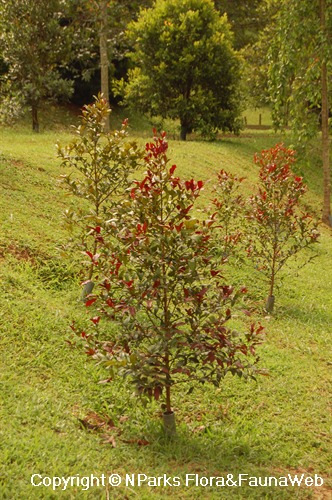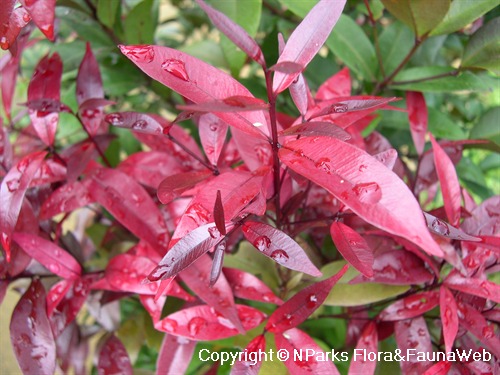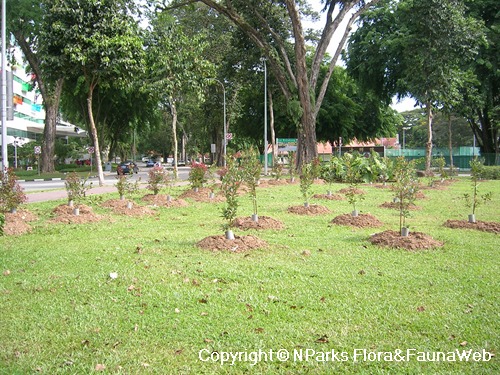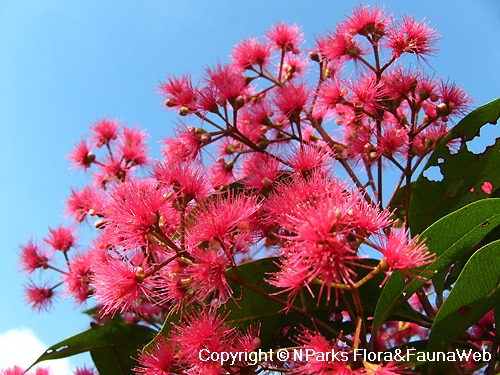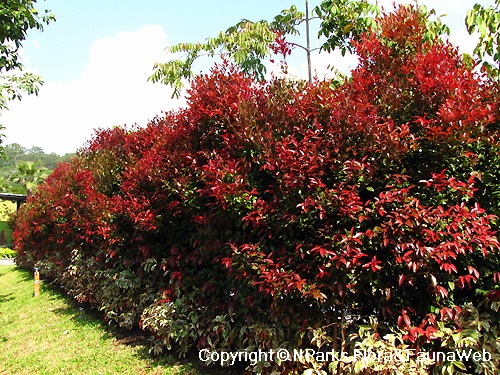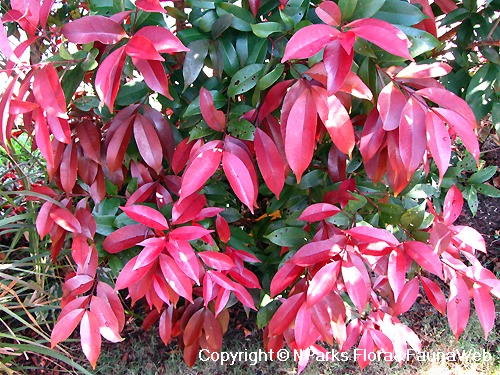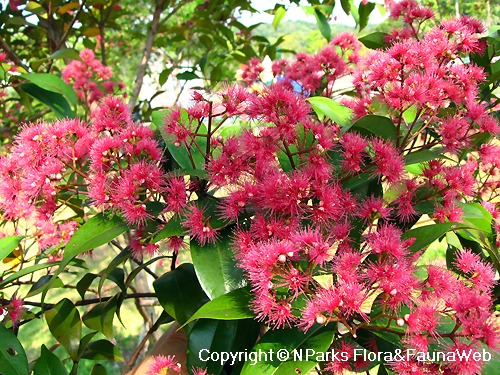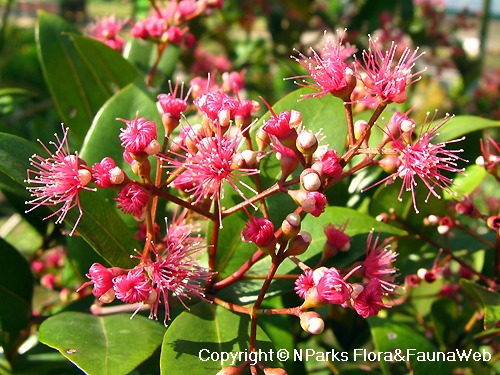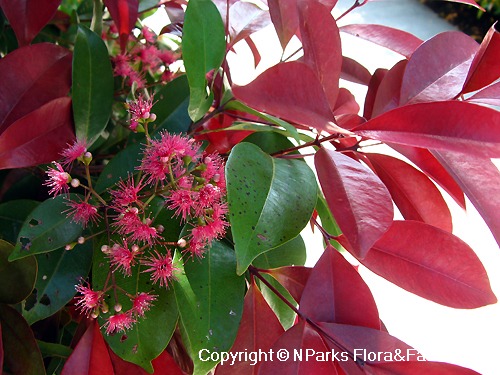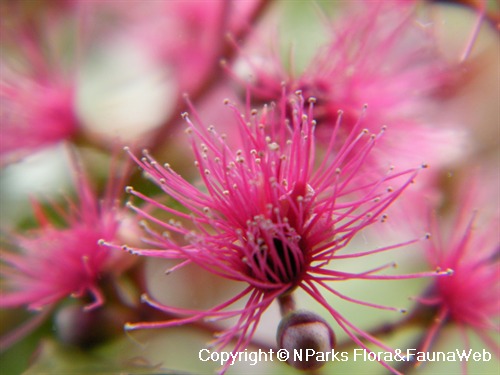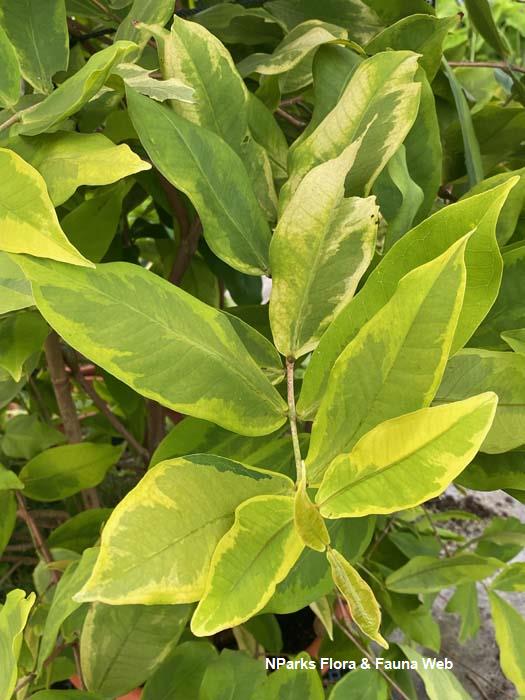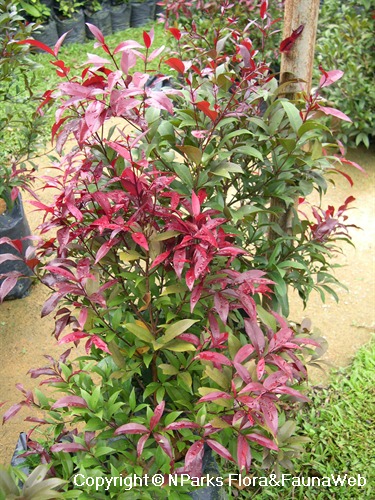
Name
Classifications and Characteristics
| Plant Division | Angiosperms (Flowering Seed Plants) (Dicotyledon) |
|---|---|
| Plant Growth Form | Shrub, Tree |
| Lifespan (in Singapore) | Perennial |
| Mode of Nutrition | Autotrophic |
| Plant Shape | Compact |
| Maximum Height | 6 m to 10 m |
| Maximum Plant Spread / Crown Width | 3 m to 5 m |
Biogeography
| Native Habitat | Terrestrial |
|---|---|
| Local Conservation Status | Non-native |
Description and Ethnobotany
| Growth Form | A shrub or small tree with a dense crown. |
|---|---|
| Foliage | The foliages are oppositely arranged, with elliptical shape. The young foliages are dark red which will turn green as they mature. |
| Flowers | The flowers are bright pink in colour, clustered inflorescence. |
| Similar | It has the same form and usage as the more common Syzygium myrtifolium, which has reddish to red brown young foliage. |
| Etymology | The genus 'Syzygium' is derived from 'syzygos' (Greek for 'joined'), which means paired, by refering to the opposite paired leaves. Specific epithet 'myrtifolium' means myrtle-leaved, which describes the plant's foliar shape and texture resembling the leaves of Myrtus. |
Landscaping Features
| Landscaping | This plant is suitable to be planted along the streets, parks and gardens. |
|---|---|
| Desirable Plant Features | Ornamental Flowers, Ornamental Foliage, Fragrant (Flowers, Foliage) (Time Independent) |
| Landscape Uses | General, Suitable for Roadsides, Hedge / Screening, Topiary, Container Planting, Parks & Gardens, Coastal, Riverine, Suitable for Bonsai |
| Thematic Landscaping | Naturalistic Garden, Formal Garden |
Fauna, Pollination and Dispersal
| Fauna Pollination Dispersal Associated Fauna | Bird-Attracting |
|---|---|
| Pollination Method(s) | Biotic (Fauna) |
| Seed or Spore Dispersal | Biotic (Fauna) |
Plant Care and Propagation
| Light Preference | Full Sun |
|---|---|
| Water Preference | Moderate Water |
| Plant Growth Rate | Moderate |
| Rootzone Tolerance | Fertile Loamy Soils, Well-Drained Soils, Easy to Grow, Moist Soils, Saline Soils / Salt Spray |
| Maintenance Requirements | Moderate |
| Propagation Method | Stem Cutting |
Foliar
| Foliage Retention | Evergreen |
|---|---|
| Mature Foliage Colour(s) | Green |
| Mature Foliage Texture(s) | Smooth, Glossy / Shiny |
| Young Flush Texture(s) | Glossy / Shiny |
| Foliar Type | Simple / Unifoliate |
| Foliar Arrangement Along Stem | Opposite |
| Foliar Attachment to Stem | Petiolate |
| Foliar Shape(s) | Non-Palm Foliage (Elliptical) |
| Foliar Venation | Pinnate / Net |
| Foliar Margin | Entire |
| Foliar Apex - Tip | Acute |
| Foliar Base | Rounded / Obtuse |
| Leaf Area Index (LAI) for Green Plot Ratio | 4.5 (Shrub & Groundcover - Dicot) |
| Prominent Young Flush Colour(s) Remarks | Dark Red |
Non - Foliar and Storage
| Trunk Type (Non Palm) | Woody |
|---|---|
| Mature Bark Texture | Smooth |
| Stem Type & Modification | Woody |
| Root Type | Underground (Tap Root, Fibrous Root) |
Floral (Angiosperm)
| Flower & Plant Sexuality | Bisexual Flowers |
| Flower Colour(s) | Pink, Red |
|---|---|
| Flower Grouping | Cluster / Inflorescence |
| Flower Location | Axillary |
| Flower Symmetry | Radial |
| Inflorescence Type | Panicle |
| Flowering Period | Rarely |
| Flowering Habit | Polycarpic |
Image Repository
Others
| Master ID | 1864 |
|---|---|
| Species ID | 3157 |
| Flora Disclaimer | The information in this website has been compiled from reliable sources, such as reference works on medicinal plants. It is not a substitute for medical advice or treatment and NParks does not purport to provide any medical advice. Readers should always consult his/her physician before using or consuming a plant for medicinal purposes. |

